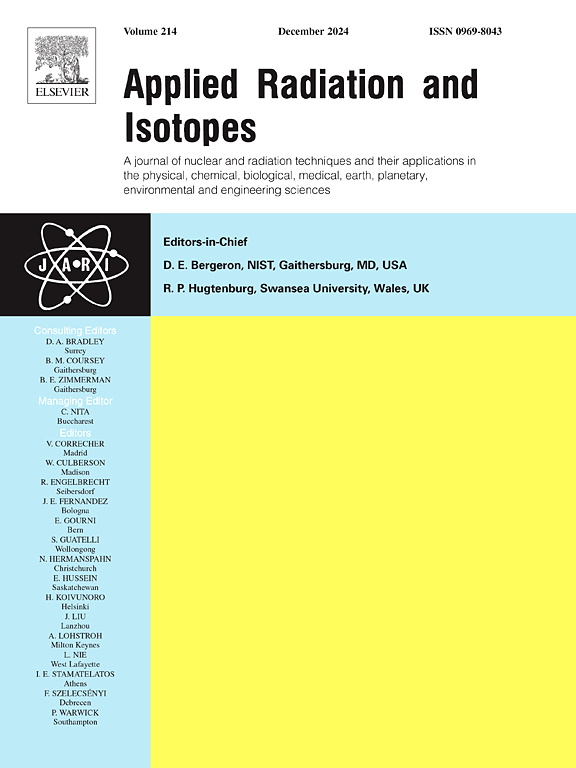利用中子活化分析和能量色散x射线荧光技术对耕地土壤和作物样品进行元素表征
IF 1.6
3区 工程技术
Q3 CHEMISTRY, INORGANIC & NUCLEAR
引用次数: 0
摘要
这项研究工作调查了旁遮普邦纳旺沙尔地区可耕地土壤中的元素分布,并从当地农民那里收集了作物样本,为养分浓度、潜在污染及其对农业可持续性的影响提供了见解。从旁遮普纳万沙尔地区选定的10个农业地点收集作物和土壤样本,随后使用放射性分析技术进行分析;通过孟买BARC的气动载体设施(PCF)和能量色散x射线荧光(ED-XRF)进行仪器中子活化分析(INAA)。这些方法能够精确量化基本元素:Al、Fe、Na、K、Ca、Mg、Mn和Zn,揭示土壤和作物样品中的分布模式。在土壤中,浓度值依次为:Al >;菲比;Na在K比;Ca比;Mg祝辞Mn祝辞Zn,而在作物中,它转变为Al >;Ca比;菲比;Na在Mg祝辞锌比;锰。经分析,土壤元素浓度与作物元素浓度之间存在很强的相关性,其中锌(Zn)从土壤到植物的吸收效率最高。而Fe、Mn、Na、Al等元素之间的关系不显著。锌积累对作物产量生产力也有影响。为了评估土壤样品中的元素积累,计算了污染因子(CF),突出了耕地土壤中Ca和Zn的积累。还对利用ED-XRF获得的作物和土壤样品的检出限进行了评估,强调了评估主要元素和次要元素对提高土壤和作物质量的重要性,从而促进可持续农业和确保长期粮食安全。本文章由计算机程序翻译,如有差异,请以英文原文为准。
Elemental characterisation of arable soil and crop samples employing neutron activation analysis and energy dispersive X-ray fluorescence technique
This research work investigates into the elemental distribution within arable soil and locally collected crop samples from farmers of Nawanshahr region of Punjab, offering insights into nutrient concentration, potential contamination, and their impact on agricultural sustainability. Crop and soil samples were collected from 10 selected agricultural sites at Nawanshahr region of Punjab and subsequently analyzed using radioanalytical technique; Instrumental Neutron Activation Analysis (INAA) via the Pneumatic Carrier Facility (PCF) at BARC, Mumbai and Energy Dispersive X-ray Fluorescence (ED-XRF). These methodologies enabled precise quantification of essential elements: Al, Fe, Na, K, Ca, Mg, Mn and Zn, revealing distribution patterns in soil and crop samples. In soil, the concentration value followed: Al > Fe > Na > K > Ca > Mg > Mn > Zn, while in crops, it shifted to Al > Ca > Fe > Na > Mg > Zn > Mn. Upon analysis, a strong correlation was observed between soil and crop elemental concentrations, for zinc (Zn) showing the highest uptake efficiency from soil to plant. However, other elements such as Fe, Mn, Na and Al exhibited insignificant relationships. It was also observed that Zn accumulation has an impact on crop yield productivity. To assess elemental accumulation in soil samples, the Contamination Factor (CF) was calculated, highlighting the accumulation of Ca and Zn in arable soil. The limit of detection values obtained for crop and soil samples using ED-XRF were also evaluated, underscoring the importance of assessing both major and minor elements to enhance soil and crop quality, thereby fostering sustainable agriculture and ensuring long-term food security.
求助全文
通过发布文献求助,成功后即可免费获取论文全文。
去求助
来源期刊

Applied Radiation and Isotopes
工程技术-核科学技术
CiteScore
3.00
自引率
12.50%
发文量
406
审稿时长
13.5 months
期刊介绍:
Applied Radiation and Isotopes provides a high quality medium for the publication of substantial, original and scientific and technological papers on the development and peaceful application of nuclear, radiation and radionuclide techniques in chemistry, physics, biochemistry, biology, medicine, security, engineering and in the earth, planetary and environmental sciences, all including dosimetry. Nuclear techniques are defined in the broadest sense and both experimental and theoretical papers are welcome. They include the development and use of α- and β-particles, X-rays and γ-rays, neutrons and other nuclear particles and radiations from all sources, including radionuclides, synchrotron sources, cyclotrons and reactors and from the natural environment.
The journal aims to publish papers with significance to an international audience, containing substantial novelty and scientific impact. The Editors reserve the rights to reject, with or without external review, papers that do not meet these criteria.
Papers dealing with radiation processing, i.e., where radiation is used to bring about a biological, chemical or physical change in a material, should be directed to our sister journal Radiation Physics and Chemistry.
 求助内容:
求助内容: 应助结果提醒方式:
应助结果提醒方式:


